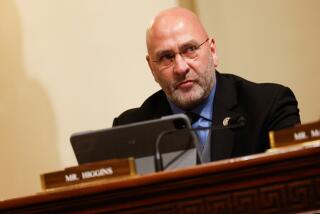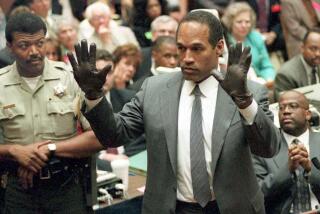Simulation and Cold Reality: The Twain Meet in TV News : Hanging Video: What Is TV’s Role in Terror?
- Share via
The videotape was shadowy and grainy. Yet clearly visible was the body of a man, swirling slowly while dangling from a gallows.
This time no one could accuse television of sanitizing or glamorizing violence. On the contrary, by showing gruesome footage of a man purported to be executed American hostage Lt. Col. Williams R. Higgins, newscast after newscast had raised another issue.
This time did TV go too far?
Was outrage over Higgins’ apparent murder escalating to hysteria, prodded by TV? Would these grisly pictures--supplied by his Shiite Moslem captors in an orchestrated media spectacle as macabre as anyone could imagine--dangerously inflame public emotions, thereby pushing President Bush into an ill-advised, hasty response?
Television’s ability to intensify experiences is unique. It repeats events--actually replays them on the screen--that newspapers can only refer to in the past tense. The result can be devastating: a psychological conditioning, a shaping or changing of perceptions by constant repetition.
So the purported Higgins death tape can be rerun again and again, with reporters, government officials and terrorism experts weighing in with analysis and speculation, jolting our consciousness and leaving an indelible impression.
Or would the death pictures have the opposite effect, desensitizing viewers to the horror of the apparent execution?
Whatever the ultimate answer, there was something ghoulish in the way the tape was used on much of American TV Monday, a body displayed like a piece of meat, as if the apparent death of Higgins at the hands of pro-Iranian terrorists was to be prime time for gawkers.
The captors control our memories of their hostages from across the seas. As a nation, sadly, we recall them only when their captors wish us to recall them. “They have the power to impale millions of us on powerful images,” Peter Jennings said of the terrorists in leading off Monday’s “World News Tonight” on ABC.
There are times, however, when the media assist with the impaling.
Undoubtedly, it was necessary for the public to see at least a portion of the so-called Higgins tape, in some form, if only to understand the brutality of the crime. A still shot of the body and a mention of its resemblance to Higgins would have sufficed. But TV news producers thought differently.
How much was too much? This much.
Nearly all newscasts aired not only footage of the body twisting at the end of the rope, but also a closeup of the victim’s face. It was grotesque. It was obscene. It was unnecessary. And it was dangerous, inviting hysterical reaction and potentially making it harder for the Administration to proceed with quiet diplomacy. By whipping up public opinion, such coverage can perilously accelerate the decision-making process.
Said Bush, protesting the apparent murder of Higgins: “Somehow there has got to be a return to decency and honor, even in matters of this nature.” And in media coverage of matters of this nature, too.
Monday’s edition of “The CBS Evening News” aired a still picture of the hanging body followed by tape of the body and also that ghastly closeup. The “NBC Nightly News” showed a still of the body, followed by tape, followed later by a replay of the still.
CNN and “The MacNeil/Lehrer NewsHour” on PBS showed the tape of the body swinging and the closeup.
ABC’s “World News Tonight” showed only stills of the body from various angles, including the closeup of the head. “No need for us to demean Col. Higgins by showing him swinging,” said Jennings, sounding sanctimonious while appearing to take a swipe at his competition. But the swinging body was no more demeaning than the stationary closeup that ABC showed, a closeup that resembled a death mask.
On the local front, KCBS-TV Channel 2 used footage of only the swaying body’s legs and stills of the head on its 5 p.m. newscast, followed by only the stills on the 6 p.m. newscast. KABC-TV Channel 7 used stills of the body and face. Other local stations used the body/face tape footage, staging a mini-horror show.
So much of TV is a show. The same box that brings you the chilling spectacle of a murdered American also brings you entertainment. Not long after after watching the Higgins footage with Jennings or Dan Rather or Tom Brokaw, much of the news audience was probably emersed in “MacGyver” or “Kate & Allie” or “Alf.”
This is a medium where CNN’s “Larry King Live” opened Monday night with a sober discussion of the Higgins case and closed with Vanna White, a medium where everyone sits at the same lunch counter and inevitably uses the same menu.
So, naturally, KNBC’s opening footage of Higgins came shortly after a funny news promo starring sportcaster Fred Roggin and weathercaster Fritz Coleman as synchronized swimmers.
Naturally, KCBS followed the Higgins story with a commercial break that included a “Channel 2 Action News at 5” promo grouping its broadly smiling anchors for a family portrait. Most of the news is bad. Why are they smiling?
Naturally, KABC, prior to giving way to “World News Tonight” at 7 p.m., teased its 11 p.m. newscast by again showing a closeup of the apparent hanging victim’s face. In some ways, then, the story had already been bent to the needs of TV promotion.
Pulitzer Prize-winning reporter Thomas Friedman of the New York Times charged on “Nightline” Monday that Higgins had been exploited in this tragedy by both his terrorist captors and the Israelis. Add TV, too, with results yet to be determined.
More to Read
The complete guide to home viewing
Get Screen Gab for everything about the TV shows and streaming movies everyone’s talking about.
You may occasionally receive promotional content from the Los Angeles Times.






